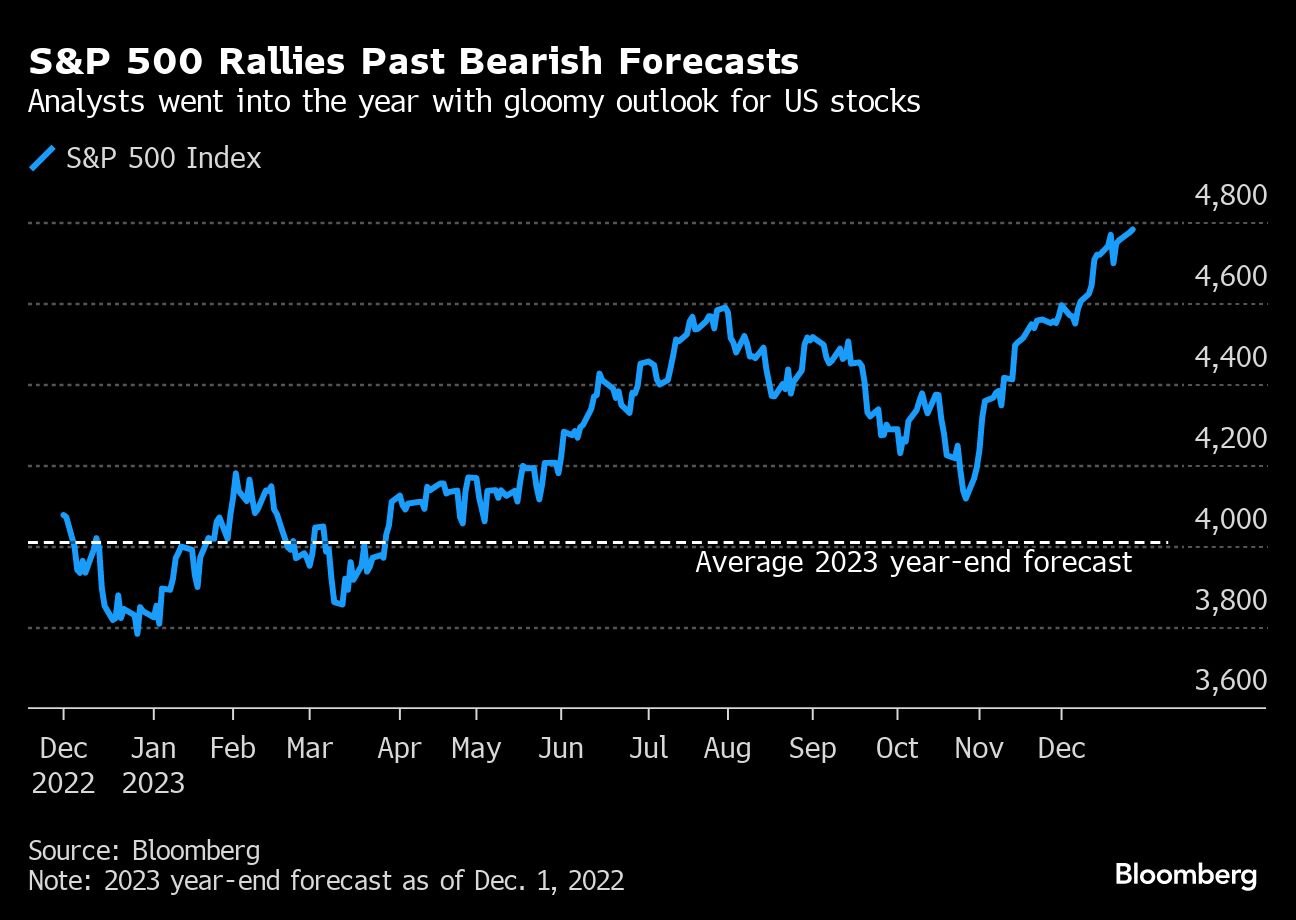What You Have to Know
- Three calls — promote U.S. shares, purchase U.S. Treasury payments and buy Chinese language shares — shaped the consensus view.
All throughout Wall Avenue, on equities desks and bond desks, at big companies and area of interest outfits, the temper was glum. It was the top of 2022 and everybody, it appeared, was game-planning for the recession they have been satisfied was coming.
Over at Morgan Stanley, Mike Wilson, the bearish inventory strategist who was quickly changing into a market darling, was predicting the S&P 50O Index was about to tumble.
A couple of blocks away at Financial institution of America, Meghan Swiber and her colleagues have been telling purchasers to organize for a plunge in Treasury bond yields. And at Goldman Sachs, strategists together with Kamakshya Trivedi have been speaking up Chinese language property because the economic system there lastly roared again from Covid lockdowns.
Blended collectively, these three calls — promote U.S. shares, purchase Treasuries, purchase Chinese language shares — shaped the consensus view on Wall Avenue.
And, as soon as once more, the consensus was useless improper.
What was alleged to go up went down, or listed sideways, and what was alleged to go down went up — and up and up. The S&P 500 climbed greater than 20% and the Nasdaq 100 soared over 50%, the largest annual acquire for the reason that go-go days of the dot-com growth.
It’s a testomony largely to the best way the financial forces unleashed within the pandemic — primarily, booming shopper demand that fueled each progress and inflation — proceed to bewilder the very best and brightest in finance and, for that matter, in coverage making circles in Washington and overseas.
And it places the promote aspect — because the high-profile analysts are recognized to all on Wall Avenue — in a really uncomfortable place with traders internationally who pay for his or her opinions and recommendation.
“I’ve by no means seen the consensus as improper because it was in 2023,” mentioned Andrew Pease, the chief funding strategist at Russell Investments, which oversees round $290 billion in property. “After I take a look at the promote aspect, everybody acquired burned.”

Cash managers at outlets like Russell got here out wanting alright this 12 months, producing returns in shares and bonds which are barely increased on common than the positive factors in benchmark indexes.
However Pease, to be clear, didn’t fare a lot better along with his forecasts than the celebs on the promote aspect. The basis of his mistake was the identical as theirs: a nagging sense that the U.S. — and far of the remainder of the world — have been about to sink right into a recession.
This was logical sufficient. The Federal Reserve was within the midst of its most aggressive interest-rate-hiking marketing campaign in a long time and spending by shoppers and corporations appeared positive to buckle.
There have been few indicators of that up to now, although. The truth is, progress really quickened this 12 months as inflation receded. Throw into the combination a pair of breakthroughs in synthetic intelligence — the recent new factor on the earth of tech — and also you had the right cocktail for a bull marketplace for shares.
S&P 500 & Wilson’s Predictions
The 12 months began with a bang. The S&P 500 jumped 6% in January alone. By mid-year, it was up 16%, after which, when the inflation slowdown fueled rampant hypothesis the Fed would quickly begin reversing its price hikes, the rally quickened anew in November, propelling the S&P 500 to inside spitting distance of a report excessive.
By way of all of it, Wilson, Morgan Stanley’s chief U.S. fairness strategist, was unmoved. He had accurately predicted the 2022 stock-market rout that few others noticed coming — a name that helped make him the top-ranked portfolio strategist for 2 straight years in Institutional Investor surveys — and he was sticking to that pessimistic view.
In early 2023, he mentioned, shares would fall so sharply that, even with a second-half rebound, they’d find yourself mainly unchanged.
He out of the blue had loads of firm, too.
Final 12 months’s selloff, sparked by the speed hikes, spooked strategists. By early that December, they have been predicting that fairness costs would drop once more within the 12 months forward, in accordance with the common estimate of these surveyed by Bloomberg. That form of bearish consensus hadn’t been seen in a minimum of 23 years.
Even Marko Kolanovic, the JPMorgan Chase strategist who had insisted via a lot of 2022 that shares have been on the cusp of a rebound, had capitulated. (That dour sentiment has prolonged into subsequent 12 months, with the common forecast calling for nearly no positive factors within the S&P 500.)
It was Wilson, although, who turned the general public face of the bears, satisfied that a 2008-type crash in company earnings was on the horizon. Whereas merchants have been betting that cooling inflation can be good for shares, Wilson warned of the alternative — saying it will erode firms’ revenue margins simply because the economic system slowed.
In January, he mentioned even the downbeat Wall Avenue consensus was too sanguine and predicted the S&P may drop greater than 20% earlier than lastly snapping again.
A month later, he warned purchasers the market’s risk-reward dynamic “is as poor because it’s been at any time throughout this bear market.”
And in Might, with the S&P up almost 10% on the 12 months, he urged traders to not be duped: “That is what bear markets do: they’re designed to idiot you, confuse you, make you do belongings you don’t need to do.”